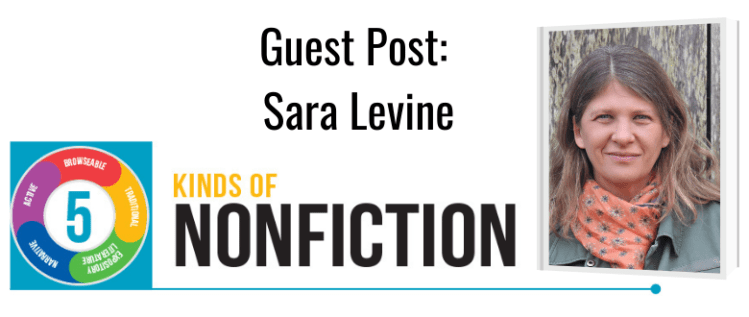5 Kinds of Nonfiction: Sara Levine

We explore Expository Literature with Sara Levine, author of Eye by Eye: Comparing How Animals See. The playful picture book keeps readers guessing as they learn wonderfully weird and gross facts and find out how different animal’s eyes are like—and unlike—those of starfish, owls, slugs, and more! Keep reading to learn more about Sara’s process, and about Expository Literature and the 5 Kinds of Nonfiction.
The books in my Animal by Animal series explore how humans are alike and different from other animals using an interactive and playful format— they teach comparative anatomy.

The first book, Bone by Bone: Comparing Animal Skeletons, evolved from teaching an undergraduate class in human biology. As a veterinarian, I like to loop in information about animals in my teaching, to show how we are all connected. I realized that students did not know that humans have basically the same biology as other animals—same bones, same organs, same diseases, and so on. It is the differences between us and other animals that make things interesting. So, when teaching about bones, I started asking questions like, “What kind of animal would you be if your finger bones extended down to your feet?” (The answer is a bat, in case you are wondering.) This sort of call and response game engaged my students, and I realized it would make a good format for a science picture book.
The voice in the book is really my own teaching voice. I like to ask questions that make people think about topics in new ways. And I like to address my readers directly as though I am talking to them. I think it creates a certain level intimacy and respect that kids respond to. They can feel involved as part of their learning process. And I also like to be silly. Learning about science can and should be fun.
The other books in the series follow the same format, which allows for T.S Spookytooth, illustrator extraordinaire, to draw humans with wacky characteristics (such a human with fingers all the way to the ground or one with eyeballs on long stalks that extend from the face). His illustrations are entertaining and thought-provoking, and they encourage readers to guess the animal before turning the page find out the answers.
The topic of the most recent book in the Animal by Animal series, Eye by Eye: Comparing How Animals See, was actually suggested by a group of third graders when I was a guest author visiting their school. We brainstormed animals with unusual eyes, and I went home and wrote a draft that night. I was able to draw on some information I already knew from veterinary school and from teaching natural history, but I needed to do science research to further my knowledge of variation in eye structure and function.
I started with some very cool examples I already knew about, such as the slug which can extend and retract its eyes from its head, and the flounder which has one eye that actually migrates from one side of its face to join the other, and then I discovered new ones. For example, did you know there is an animal that has pupils shaped like the letter W? What kind of animal has pupils like that? You’ll have to read the book to find out!

Expository Literature is a category of Melissa Stewart’s Five Kinds of Nonfiction. This post is part of a weekly series of guest articles by nonfiction authors about their craft, their process, and their amazing books. Stay tuned each week to learn more by visiting the 5 Kinds of Nonfiction page for poster and flyer downloads, curated booklists and more. You can also follow the Lerner Blog’s 5 Kinds of Nonfiction series, or the hashtag #5KNF on Facebook, Twitter, Instagram, and LinkedIn.
Comments